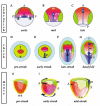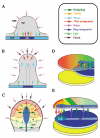Early steps in the development of the forebrain
- PMID: 14960272
- PMCID: PMC2789258
- DOI: 10.1016/s1534-5807(04)00027-9
Early steps in the development of the forebrain
Abstract
The tremendous complexity of the adult forebrain makes it a challenging task to elucidate how this structure forms during embryonic development. Nevertheless, we are beginning to understand how a simple epithelial sheet of ectoderm gives rise to the labyrinthine network of cells that constitutes the functional forebrain. Here, we discuss early events in forebrain development--those that lead to the establishment of the anterior neural plate and the regional subdivision of this territory into the different domains of the prospective forebrain.
Figures




References
-
- Adelmann HB. The problem of cyclopia. Q. Rev. Biol. 1936;11:116–182. 284–364.
-
- Agathon A, Thisse C, Thisse B. The molecular nature of the zebrafish tail organizer. Nature. 2003;424:448–452. - PubMed
-
- Akai J, Storey K. Brain or brawn: how FGF signalling gives us both. Cell. 2003;115:510–512. - PubMed
-
- Anderson RM, Lawrence AR, Stottmann RW, Bachiller D, Klingensmith J. Chordin and noggin promote organizing centers of forebrain development in the mouse. Development. 2002;129:4975–4987. - PubMed
-
- Aoto K, Nishimura T, Eto K, Motoyama J. Mouse GLI3 regulates Fgf8 expression and apoptosis in the developing neural tube, face, and limb bud. Dev. Biol. 2002;251:320–332. - PubMed
Publication types
MeSH terms
Substances
Grants and funding
LinkOut - more resources
Full Text Sources

